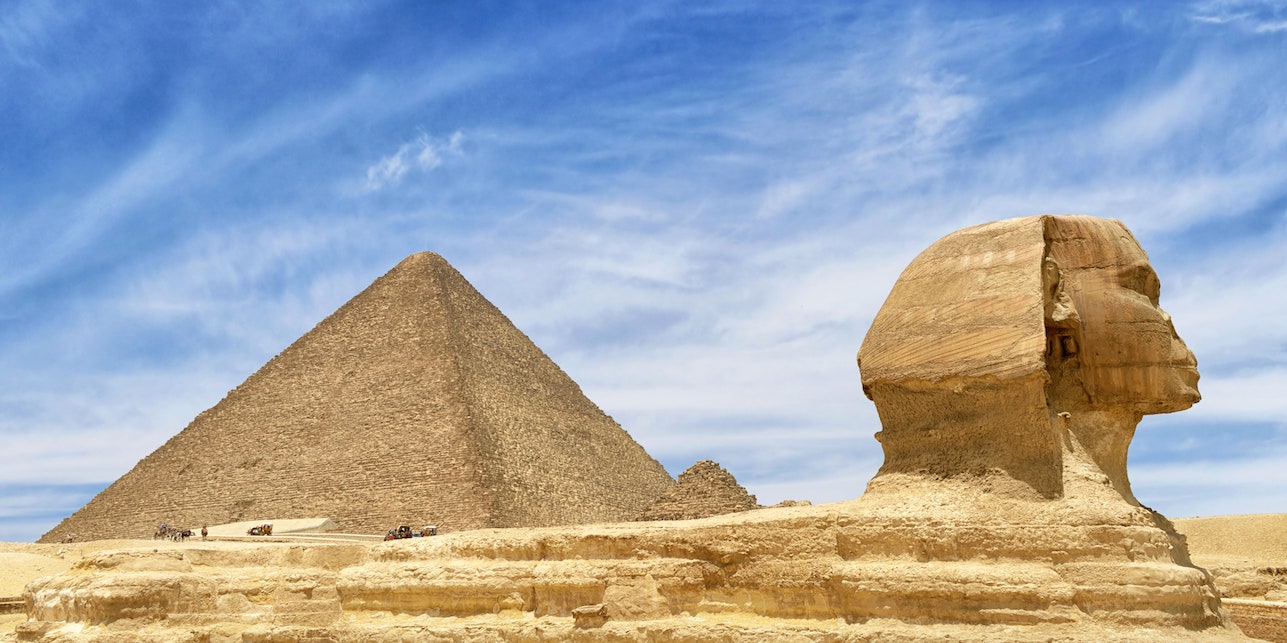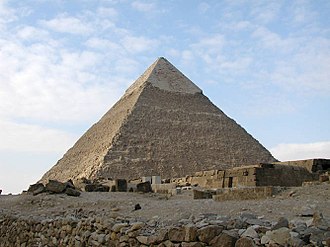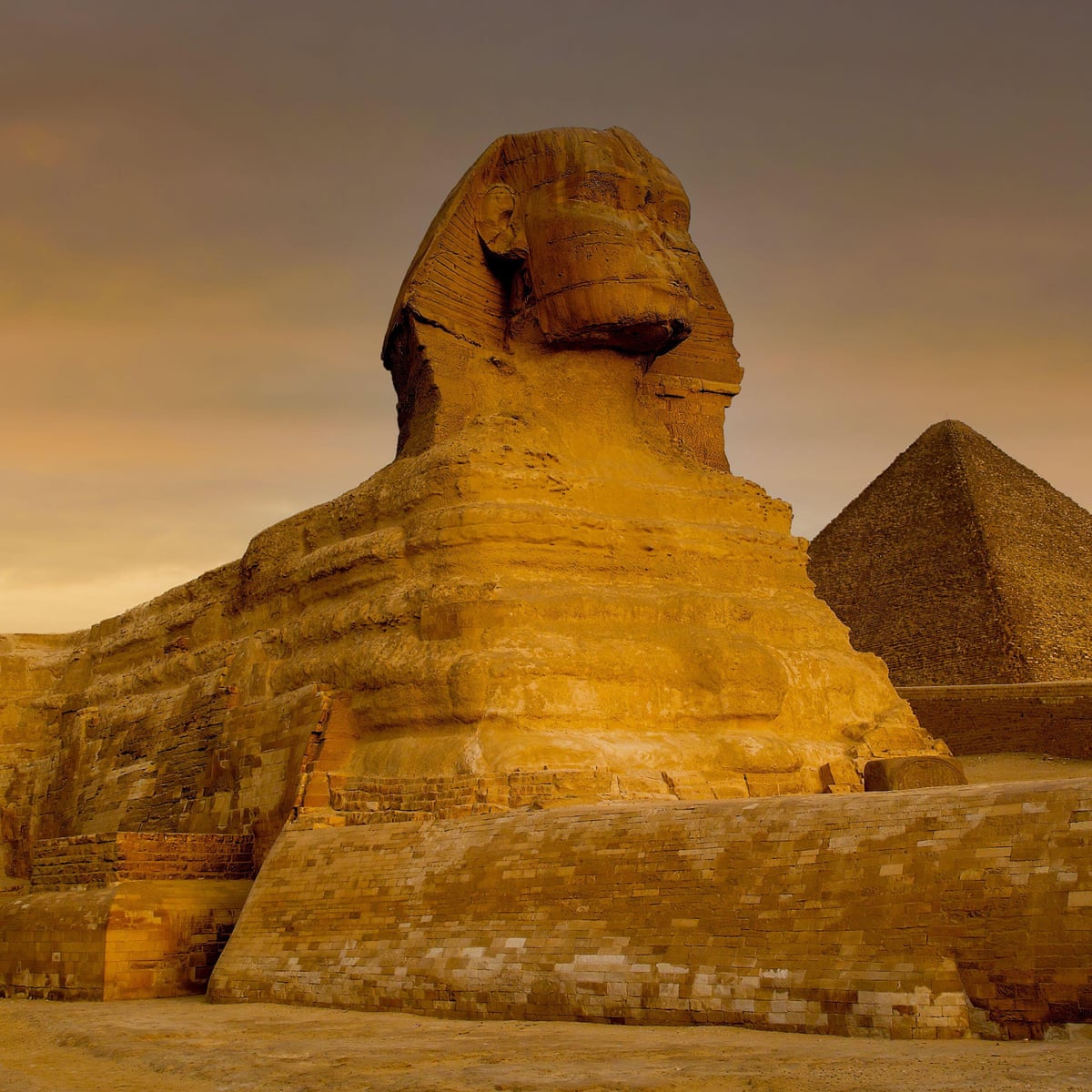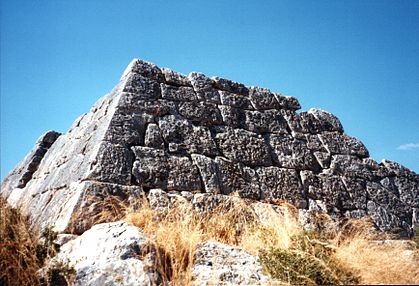Pyramid
A pyramid (from Greek: πυραμίς pyramís)is a structure whose outer surfaces are triangular and converge to a single step at the top, making the shape roughly a pyramid in the geometric sense. The base of a pyramid can be trilateral, quadrilateral, or of any polygon shape. As such, a pyramid has at least three outer triangular surfaces (at least four faces including the base). The square pyramid, with a square base and four triangular outer surfaces, is a common version.
A pyramid's design, with the majority of the weight closer to the ground,and with the pyramidion at the apex, means that less material higher up on the pyramid will be pushing down from above. This distribution of weight allowed early civilizations to create stable monumental structures.
Civilizations in many parts of the world have built pyramids. The largest pyramid by volume is the Great Pyramid of Cholula, in the Mexican state of Puebla. For thousands of years, the largest structures on Earth were pyramids—first the Red Pyramid in the Dashur Necropolis and then the Great Pyramid of Khufu, both in Egypt—the latter is the only one of the Seven Wonders of the Ancient World still remaining.
The Mesopotamians built the earliest pyramidal structures, called ziggurats. In ancient times, these were brightly painted in gold/bronze. Since they were constructed of sun-dried mud-brick, little remains of them. Ziggurats were built by the Sumerians, Babylonians, Elamites, Akkadians, and Assyrians for local religions. Each ziggurat was part of a temple complex which included other buildings. The precursors of the ziggurat were raised platforms that date from the Ubaid period during the fourth millennium BC. The earliest ziggurats began near the end of the Early Dynastic Period.The latest Mesopotamian ziggurats date from the 6th century BC.
Built in receding tiers upon a rectangular, oval, or square platform, the ziggurat was a pyramidal structure with a flat top. Sun-baked bricks made up the core of the ziggurat with facings of fired bricks on the outside. The facings were often glazed in different colors and may have had astrological significance. Kings sometimes had their names engraved on these glazed bricks. The number of tiers ranged from two to seven. It is assumed that they had shrines at the top, but there is no archaeological evidence for this and the only textual evidence is from Herodotus.Access to the shrine would have been by a series of ramps on one side of the ziggurat or by a spiral ramp from base to summit.
The most famous pyramids are the Egyptian — huge structures built of brick or stone, some of which are among the world's largest constructions. They are shaped as a reference to the rays of the sun. Most pyramids had a polished, highly reflective white limestone surface, to give them a shining appearance when viewed from a distance. The capstone was usually made of hard stone – granite or basalt – and could be plated with gold, silver, or electrum and would also be highly reflective.The ancient Egyptians built pyramids from 2700 BC until around 1700 BC. The first pyramid was erected during the Third Dynasty by the Pharaoh Djoser and his architect Imhotep. This step pyramid consisted of six stacked mastabas. The largest Egyptian pyramids are those at the Giza pyramid complex.
The age of the pyramids reached its zenith at Giza in 2575–2150 BC.Ancient Egyptian pyramids were in most cases placed west of the river Nile because the divine pharaoh's soul was meant to join with the sun during its descent before continuing with the sun in its eternal round.As of 2008, some 135 pyramids have been discovered in Egypt.The Great Pyramid of Giza is the largest in Egypt and one of the largest in the world. At 481 ft, it was the tallest building in the world until Lincoln Cathedral was finished in 1311 AD. The base is over 52,600 square metres (566,000 sq ft) in area. The Great Pyramid of Giza is one of the Seven Wonders of the Ancient World. It is the only one to survive into modern times. The Ancient Egyptians covered the faces of pyramids with polished white limestone, containing great quantities of fossilized seashells.Many of the facing stones have fallen or have been removed and used for construction in Cairo.
Most pyramids are located near Cairo, with only one royal pyramid being located south of Cairo, at the Abydos temple complex. The pyramid at Abydos, Egypt were commissioned by Ahmose I who founded the 18th Dynasty and the New Kingdom.The building of pyramids began in the Third Dynasty with the reign of King Djoser.Early kings such as Snefru built several pyramids, with subsequent kings adding to the number of pyramids until the end of the Middle Kingdom.
The last king to build royal pyramids was Ahmose,with later kings hiding their tombs in the hills, such as those in the Valley of the Kings in Luxor's West Bank.In Medinat Habu, or Deir el-Medina, smaller pyramids were built by individuals. Smaller pyramids with steeper sides were also built by the Nubians who ruled Egypt in the Late Period.
While pyramids are associated with Egypt, the nation of Sudan has 220 extant pyramids, the most numerous in the world.Nubian pyramids were constructed (roughly 240 of them) at three sites in Sudan to serve as tombs for the kings and queens of Napata and Meroë. The pyramids of Kush, also known as Nubian Pyramids, have different characteristics than the pyramids of Egypt. The Nubian pyramids were constructed at a steeper angle than Egyptian ones. Pyramids were still being built in Sudan as late as 200 AD.
Pausanias (2nd century AD) mentions two buildings resembling pyramids, one, 19 kilometres (12 mi) southwest of the still standing structure at Hellenikon,a common tomb for soldiers who died in a legendary struggle for the throne of Argos and another which he was told was the tomb of Argives killed in a battle around 669/8 BC. Neither of these still survive and there is no evidence that they resembled Egyptian pyramids.
There are also at least two surviving pyramid-like structures still available to study, one at Hellenikon and the other at Ligourio/Ligurio, a village near the ancient theatre Epidaurus. These buildings were not constructed in the same manner as the pyramids in Egypt. They do have inwardly sloping walls but other than those there is no obvious resemblance to Egyptian pyramids. They had large central rooms (unlike Egyptian pyramids) and the Hellenikon structure is rectangular rather than square, 12.5 by 14 metres (41 by 46 ft) which means that the sides could not have met at a point.The stone used to build these structures was limestone quarried locally and was cut to fit, not into freestanding blocks like the Great Pyramid of Giza.
The dating of these structures has been made from the pot shards excavated from the floor and on the grounds. The latest dates available from scientific dating have been estimated around the 5th and 4th centuries. Normally this technique is used for dating pottery, but here researchers have used it to try to date stone flakes from the walls of the structures. This has created some debate about whether or not these structures are actually older than Egypt, which is part of the Black Athena controversy.
Mary Lefkowitz has criticised this research. She suggests that some of the research was done not to determine the reliability of the dating method, as was suggested, but to back up an assumption of age and to make certain points about pyramids and Greek civilization. She notes that not only are the results not very precise, but that other structures mentioned in the research are not in fact pyramids, e.g. a tomb alleged to be the tomb of Amphion and Zethus near Thebes, a structure at Stylidha (Thessaly) which is just a long wall, etc. She also notes the possibility that the stones that were dated might have been recycled from earlier constructions. She also notes that earlier research from the 1930s, confirmed in the 1980s by Fracchia was ignored. She argues that they undertook their research using a novel and previously untested methodology in order to confirm a predetermined theory about the age of these structures.
Liritzis responded in a journal article published in 2011, stating that Lefkowitz failed to understand and misinterpreted the methodology.
With the Egyptian Revival movement in the nineteenth and early twentieth century, pyramids were becoming more common in funerary architecture. This style was especially popular with tycoons in the US. Hunt's Tomb in Phoenix, Arizona and Schoenhofen Pyramid Mausoleum in Chicago are some of the notable examples. Even today some people build pyramid tombs for themselves. Nicolas Cage bought a pyramid tomb for himself in a famed New Orleans graveyard.



